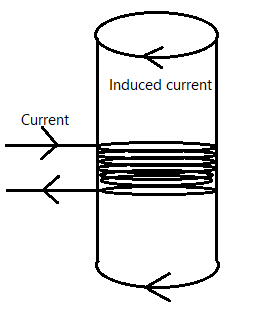
Assertion
Statement 1: A vertical iron rod has a coil of wire wound over it at the bottom end. An alternating current flows in the coil. The rod goes through a conducting ring as shown in the figure. The ring can float at a certain height above the coil.
Reason:
Statement 2: in the above situation, a current is induced in the ring which interacts with the horizontal component of the magnetic field to produce an average force in the upward direction.

A. Statement 1 is true, statement 2 is true, and statement 2 is the correct explanation for statement 1.
B. Statement 1 is true, statement 2 is true, and statement 2 is not the correct explanation for statement 1.
C. statement 1 is true, statement 2 is false
D. statement 1 is false , statement 2 is true.

Answer
564.6k+ views
Hint: We know that Lenz’s law is used to find the direction of the induced current due to the varying magnetic field. Here since the current in the coil is varying, this produces an induced current in the rod. Then we can find the force on the ring.
Complete step by step answer:
Consider the direction of current as shown in the diagram. We know that the direction of flow of the induced current in the rod is such that it opposes the change in magnetic flux caused due to the alternating current in the coil. We know this from Lenz's law.
Then from Faraday’s law we know that the emf produced by the negative rate of change of magnetic flux. The negative sign indicates the opposing nature, as given by Lenz's law.
This is denoted mathematically as: $E=\dfrac{-d\phi_{B}}{dt}$
Then, the varying current in the ring produces a varying magnetic field, which in turn induces a current in the rod, which is opposing in nature. The varying magnetic field produces a magnetic field which in turn produces an emf. Then we can say that the emf produced in the ring is responsible for the rod to float.
Thus clearly, both the statements are true. Also the statement 2 is the correct explanation of statement 1
So, the correct answer is “Option A”.
Note: Faraday's law and Lenz's law are complementary in nature. Faraday's law gives the force due to the magnetic flux, while Lenz's law gives the induced current due to the magnetic flux. And both oppose the magnetic flux.
Complete step by step answer:
Consider the direction of current as shown in the diagram. We know that the direction of flow of the induced current in the rod is such that it opposes the change in magnetic flux caused due to the alternating current in the coil. We know this from Lenz's law.
Then from Faraday’s law we know that the emf produced by the negative rate of change of magnetic flux. The negative sign indicates the opposing nature, as given by Lenz's law.
This is denoted mathematically as: $E=\dfrac{-d\phi_{B}}{dt}$
Then, the varying current in the ring produces a varying magnetic field, which in turn induces a current in the rod, which is opposing in nature. The varying magnetic field produces a magnetic field which in turn produces an emf. Then we can say that the emf produced in the ring is responsible for the rod to float.
Thus clearly, both the statements are true. Also the statement 2 is the correct explanation of statement 1
So, the correct answer is “Option A”.
Note: Faraday's law and Lenz's law are complementary in nature. Faraday's law gives the force due to the magnetic flux, while Lenz's law gives the induced current due to the magnetic flux. And both oppose the magnetic flux.
Recently Updated Pages
Master Class 12 English: Engaging Questions & Answers for Success

Master Class 12 Business Studies: Engaging Questions & Answers for Success

Master Class 12 Economics: Engaging Questions & Answers for Success

Master Class 12 Social Science: Engaging Questions & Answers for Success

Master Class 12 Maths: Engaging Questions & Answers for Success

Master Class 12 Chemistry: Engaging Questions & Answers for Success

Trending doubts
Draw a labelled sketch of the human eye class 12 physics CBSE

Explain sex determination in humans with line diag class 12 biology CBSE

The pH of the pancreatic juice is A 64 B 86 C 120 D class 12 biology CBSE

Explain sex determination in humans with the help of class 12 biology CBSE

Differentiate between homogeneous and heterogeneous class 12 chemistry CBSE

Which state in India is known as the Granary of India class 12 social science CBSE




